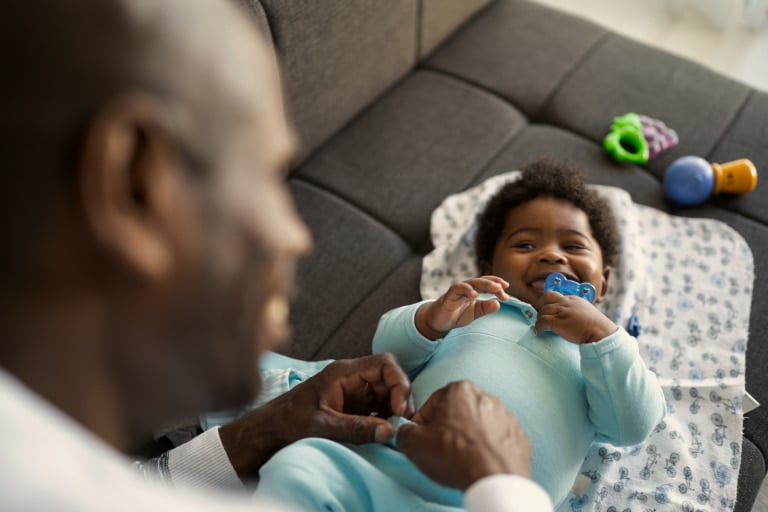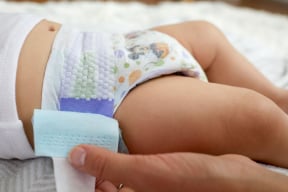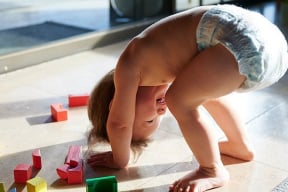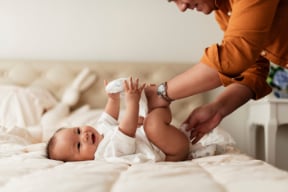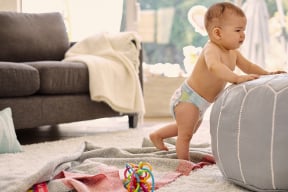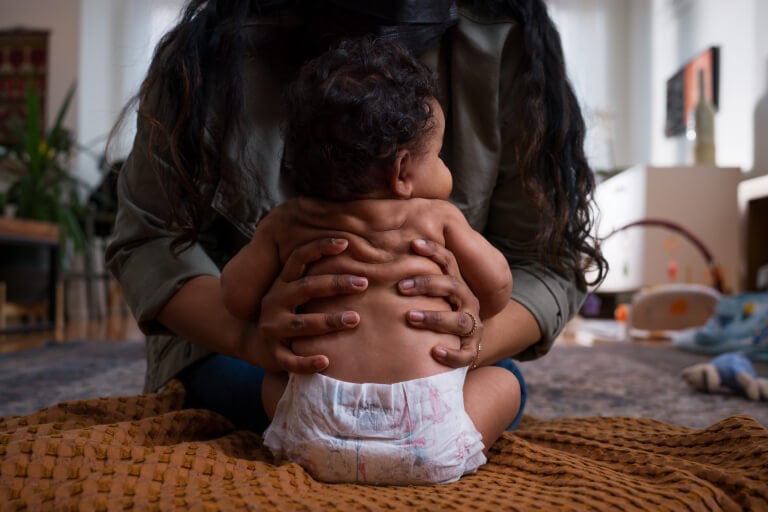Gather your changing essentials
Since a preoccupied baby is less likely to wiggle and squirm, give him something to look at while being changed, such as an unbreakable mirror or a colorful picture hanging nearby. Later on, when baby is able to grasp objects, keep favorite toys or a soft-sided picture book close at hand.
Diapering is as easy as 1-2-3
Step 1- Change the Diaper
Gently lay your baby down on a flat, firm surface. Be aware that even a tiny newborn infant can roll off a changing table. It’s vital to either use a changing table with a strap or to keep one hand on your baby at all times.
Unfasten the wet or soiled diaper and hold both your baby's legs up by carefully grasping both ankles with one hand. Remove the diaper and gently and thoroughly clean baby's bottom in and around all the creases with wipes properly formulated for baby skin. Always be sure to wipe baby's bottom from front to back. Cleaning baby skin at every diaper change can help keep skin clean and healthy.
Step 2- Check the Skin
Check the skin for any signs of irritation or diaper rash. Protect baby’s skin by applying your chosen skin protective ointment or petroleum jelly or diaper rash cream.
Step 3- Ensure fit and promote comfort
Next, slide a clean diaper under your baby so that the fasteners are in the back. Pull the diaper up between your baby's legs, making sure it's on straight, so it will wrap evenly around his hips. Then open the tabs, place them over the front of the diaper, and press them down firmly in place. For a snug fit, fasten the side closest to you first. Then roll your baby toward you to tighten and fasten the other side. Try to keep the overlap of front and back as neatly as possible so the diaper will hug your baby's waist comfortably. Inspect the diaper for proper fit. Questions about what size your baby needs? Check out this helpful article. If you need to tighten or adjust the diaper, simply lift the fasteners and reposition them anyplace on the special tab "landing zone," which is often marked by colorful characters near the top of the waistband. The fasteners on Huggies® diapers are re-closable and can be opened and fastened again as often as necessary. To help ensure maintenance of healthy skin in the diapered area, it is recommended to check baby’s diaper frequently and change it when wet and as soon as possible after baby has pooped because prolonged contact of skin with irritants present in poop and excess wetness are leading causes of diaper rash.
The Scoop On Poop
You should also be aware that breast-fed babies usually have poops of a yellowish-greenish color and those of formula-fed babies tend to look darker.
If you notice an increase in the number of your baby's bowel movements, or if you notice a change in color or odor, your baby may have a case of diarrhea and you should consult your doctor at once.
Frequent and loose poop increases the potential for irritation in the diapered area. To minimize the risk for irritation, consider using diapers that are designed with skin health in mind and can provide a secure fit. In addition, select wipes that can effectively and gently clean baby skin and support the healthy slightly acidic pH of baby skin.
Don’t be rash
Doctors say that keeping baby’s skin dry is a good way to prevent diaper rash. So check diapers often and change them as soon as they show the slightest trace of wetness. Diapers with a wetness indicator can let you know when it is time to change. Breathable diapers like Huggies® can also help keep baby's skin dry.
The Neonatal Skin Care Guidelines from the Association of Women’s Health, Obstetric and Neonatal Nurses suggest the use of a protective ointment or petroleum jelly to help keep the skin healthy.
If your baby shows signs of skin irritation that doesn’t heal within a couple of days, consider consulting your doctor to develop a skin care routine tailored to the unique needs of your baby’s skin.
For more information on how to help keep baby diapered skin healthy, check our Guide to Maintaining Healthy Diapered Skin.
Diapering on the go
What to pack? Be prepared for anything with the following diaper bag essentials: a pack of Huggies® Baby Wipes, a supply of Huggies® Diapers, plastic bags with twist ties for easy disposal of soiled diapers, whatever cream, jelly, or protective ointment you use, and—in a separate pocket of the bag—any bottles needed for meals on the go. Don't forget a small toy or rattle to distract your squirming baby while you diaper. It’s also nice to include a travel changing mat to protect your little one from potentially unsanitary surfaces in public restrooms for changes on the go.
With these helpful strategies, diaper changing can become a time of bonding and joy for you and your child.
To learn more about diapering that nurtures your baby, read the diapering guide, we created in partnership with labor and delivery nurses.
